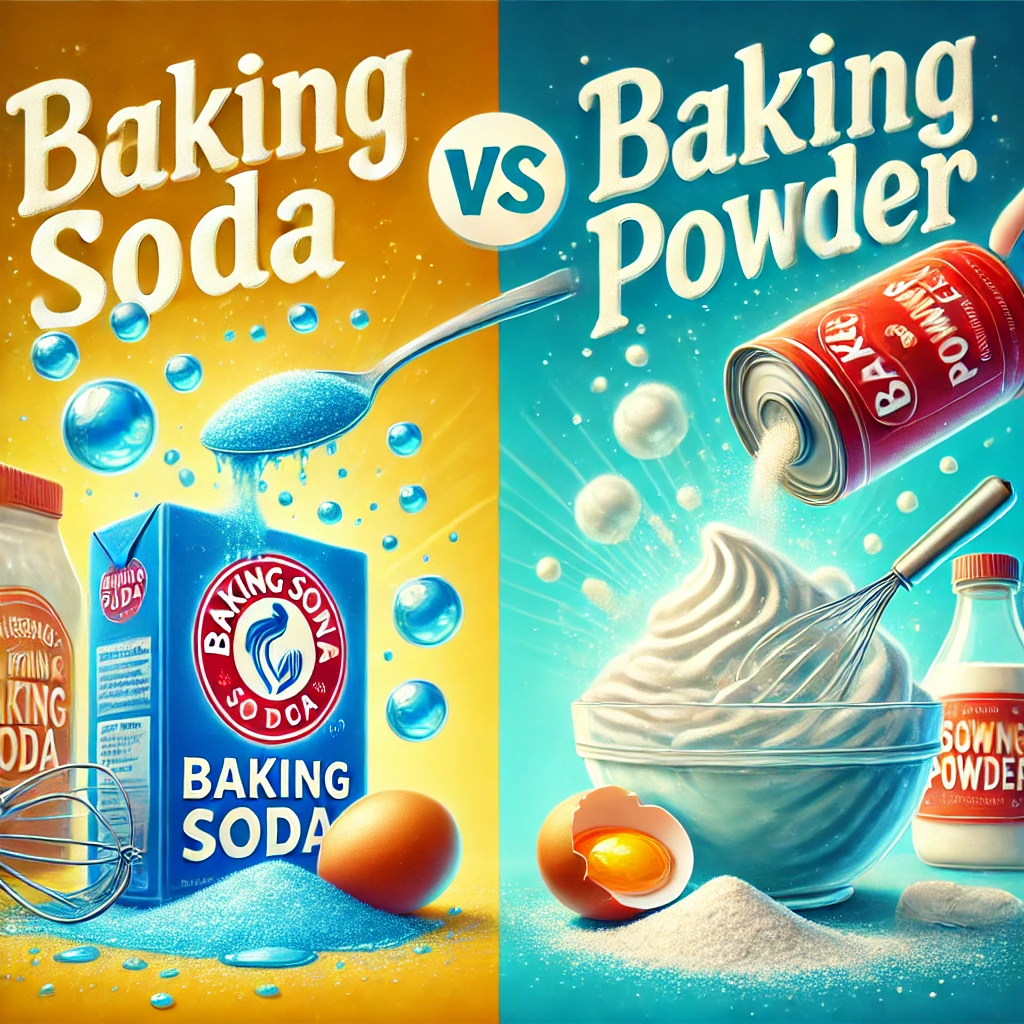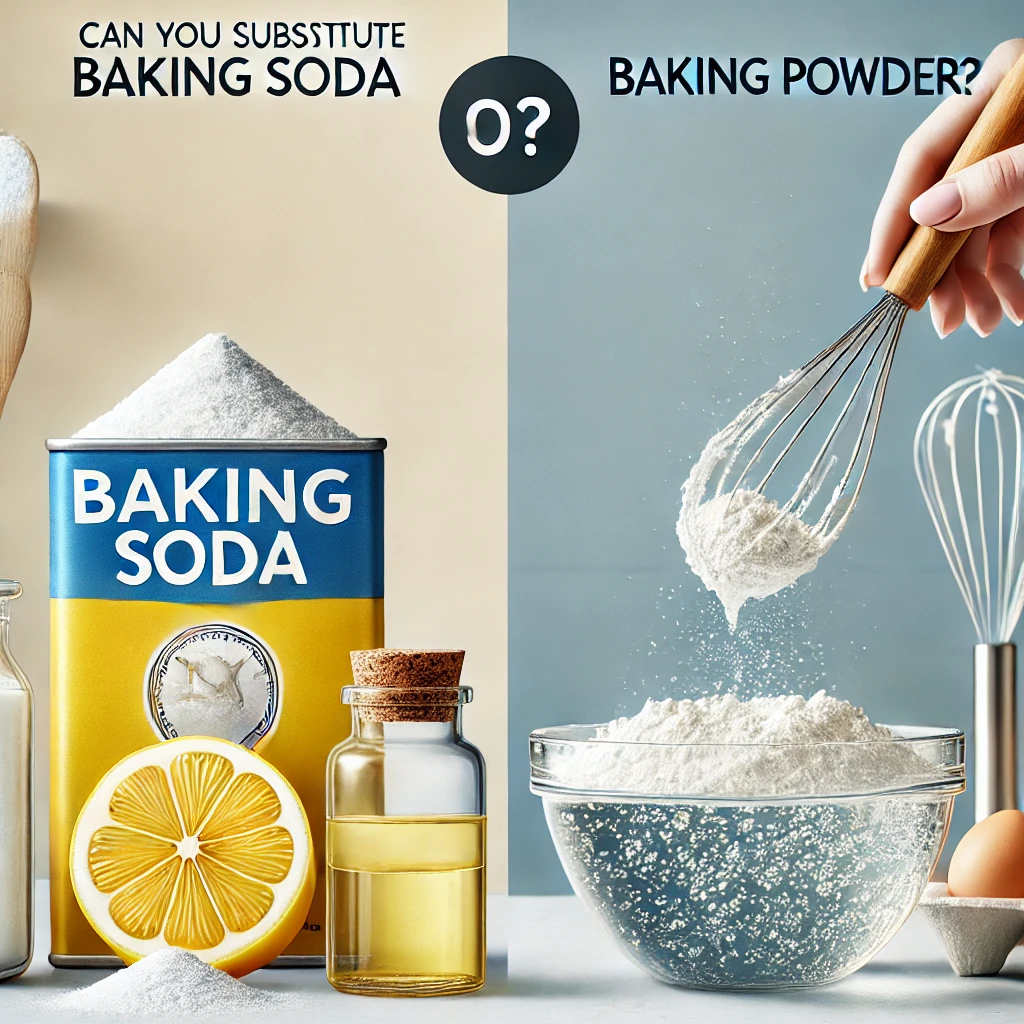
We’ve all been there—you’re halfway through a baking recipe when you realize you’re out of either baking soda or baking powder.
Panic sets in, and you wonder: Can you substitute one for the other?
This is one of the most common questions among home bakers, and while both ingredients may seem similar, they work in very different ways.
In this guide, we’ll break down the science behind baking soda and baking powder, explore their differences, and discuss if you can really swap them in your recipes.
What Are Baking Soda and Baking Powder?
Before we dive into substitutions, let’s first understand what baking soda and baking powder actually are.
- Baking Soda (Sodium Bicarbonate): Baking soda is a base, which means it requires an acidic ingredient—like buttermilk, lemon juice, or yogurt—to activate. When the two combine, they create carbon dioxide bubbles, which cause baked goods to rise. This chemical reaction happens quickly, so recipes with baking soda typically need to be baked immediately.
- Baking Powder: Unlike baking soda, baking powder already contains an acid (usually cream of tartar) and a base (baking soda). This makes it a complete leavening agent, meaning it doesn’t need any extra acid to create the rise. Most baking powders are double-acting, meaning they activate once when mixed with wet ingredients and again when exposed to heat.
The Key Differences Between Baking Soda and Baking Powder

Although baking soda and baking powder both serve as leavening agents, they are chemically distinct, and their differences can significantly impact the outcome of your baked goods.
Let’s break down these differences in more detail to help you understand how and why they work.
1. Chemical Composition
- Baking Soda (Sodium Bicarbonate): Baking soda is a single compound—sodium bicarbonate—which is a base. When it comes into contact with an acid, such as vinegar, lemon juice, or buttermilk, it reacts to produce carbon dioxide gas. This gas forms bubbles, which cause your dough or batter to rise. However, since it’s a base, baking soda requires an acidic ingredient to activate it.
- Baking Powder: Baking powder, on the other hand, is a combination of baking soda and a powdered acid (commonly cream of tartar), along with a drying agent like cornstarch to prevent clumping. Since it already contains both an acid and a base, it doesn’t need any additional acidic ingredients in the recipe to work. Most baking powders are double-acting, meaning they activate in two phases: first when mixed with wet ingredients, and second when exposed to heat during baking.
2. Reactivity and Timing
- Baking Soda: Baking soda reacts immediately when mixed with an acid, which means your batter or dough will begin to rise as soon as the two are combined. This quick reaction is why many recipes that use baking soda instruct you to bake the batter or dough right away—delaying could cause the bubbles to escape, resulting in flat or dense baked goods.
- Baking Powder: Double-acting baking powder works in two stages. The first reaction happens when it’s mixed with wet ingredients, which causes a small amount of rise. The second reaction occurs when the mixture is heated in the oven. This slower, dual-reaction process provides more stability and allows for some flexibility in timing, giving the batter time to sit before being baked without losing its leavening power.
3. Strength and Amount Used
- Leavening Power of Baking Soda: Baking soda is much stronger than baking powder—roughly three to four times more potent. As a result, recipes that use baking soda only need a small amount to achieve the desired rise. However, because baking soda needs an acidic ingredient to work, it’s typically found in recipes that contain acidic components, such as chocolate, yogurt, molasses, or brown sugar.
- Leavening Power of Baking Powder: Baking powder is milder because it already includes both an acid and a base. Therefore, you’ll need more baking powder to achieve the same rise as a small amount of baking soda. Recipes that rely solely on baking powder often contain neutral ingredients (e.g., plain flour, sugar, milk), which don’t have enough acidity to activate baking soda on its own.
4. Taste Impact
- Taste with Baking Soda: Since baking soda is basic (alkaline), it has a sharp, metallic, or bitter taste if used in excess or without enough acid to balance it out. This is why recipes using baking soda require acidic ingredients—not only to activate the rise but also to neutralize the soda’s flavor. Without this balance, your baked goods could end up tasting soapy or bitter.
- Taste with Baking Powder: Baking powder, because it contains its own acid, doesn’t leave behind the same bitter taste as baking soda. It’s more neutral in flavor, which makes it more versatile in recipes that don’t include acidic components. However, if too much baking powder is used, it can impart a slightly bitter or metallic taste, so it’s important to follow recipe guidelines closely.
5. Appearance and Texture
- Effect of Baking Soda on Texture: Baking soda’s rapid reaction produces larger gas bubbles, which can result in a more open, coarse crumb if not balanced properly. This is why recipes like chocolate chip cookies, which rely on baking soda, tend to have a chewier or crispier texture. If you use too much baking soda or don’t bake the batter right away, the finished product may have a dense or uneven crumb structure.
- Effect of Baking Powder on Texture: Baking powder’s double-action process produces smaller, more consistent gas bubbles over time, resulting in a finer, more even crumb. Cakes, muffins, and pancakes made with baking powder tend to have a light and fluffy texture due to the even distribution of the leavening action. Additionally, the second reaction (which occurs during baking) helps baked goods maintain their rise even after some initial mixing or sitting time.
6. When to Use Baking Soda vs Baking Powder
- Baking Soda: Use baking soda in recipes that include acidic ingredients, like lemon juice, yogurt, vinegar, buttermilk, brown sugar, or chocolate. Some common examples include gingerbread, banana bread, and chocolate cakes. Baking soda will provide a quick lift and contribute to a darker, browner color during baking due to the Maillard reaction (a chemical reaction between amino acids and reducing sugars that gives browned food its distinctive flavor).
- Baking Powder: Use baking powder in recipes that don’t have enough acidic ingredients on their own, like pancakes, biscuits, and plain cakes. Baking powder will create a more subtle rise and produce lighter, fluffier textures. Double-acting baking powder is ideal for recipes where the batter may need to rest or wait before being baked, as it provides a second rising phase when heat is applied.
In summary, baking soda and baking powder are both essential leavening agents, but their chemical compositions, reactivity, and effects on taste and texture vary significantly.
Understanding these key differences will help you choose the right one for your recipe and ensure your baked goods turn out perfectly every time!
Is it possible to substitute baking soda for baking powder?

Substituting baking soda for baking powder is a common question among bakers, especially when you’re in the middle of a recipe and realize you’re out of one or the other.
While it’s possible to substitute baking soda for baking powder, it’s not as straightforward as swapping them in equal amounts.
Baking soda is much stronger than baking powder, and because of the differences in their chemical composition, you’ll need to make adjustments to your recipe to ensure it still rises properly and maintains the correct taste and texture.
Let’s dive into how you can successfully substitute baking soda for baking powder and what adjustments are necessary.
1. The Strength Difference Between Baking Soda and Baking Powder
One of the biggest challenges when substituting baking soda for baking powder is the difference in strength.
Baking soda is about three to four times more potent than baking powder, meaning a little baking soda goes a long way.
- Baking Soda’s Strength: Since baking soda is pure sodium bicarbonate, it requires only a small amount to create the carbon dioxide gas needed for leavening. However, this strength means it must be balanced with an acidic ingredient.
- Baking Powder’s Mildness: Baking powder contains both sodium bicarbonate (baking soda) and an acidic component (mostly this is usually cream of tartar), along with something drying for instance, cornstarch can be used. This combination makes it a more mild leavening agent, which is why recipes generally call for more baking powder than baking soda.
If you’re substituting baking soda for baking powder, you’ll need less baking soda to get the same rising effect, and you’ll also need to add an acid to activate it.
2. How to Substitute Baking Soda for Baking Powder
Here’s a simple formula to follow when substituting:
- For every 1 teaspoon of baking powder, you can substitute it with ¼ teaspoon of baking soda, but you’ll also need to add an acid to the recipe. The acid helps to activate the baking soda, allowing it to produce the carbon dioxide gas necessary for rising.
- What Acid to Add: You have a few common options for acidic ingredients:
- Lemon juice
- Vinegar
- Buttermilk
- Yogurt
- Cream of tartar
For each teaspoon of baking powder that you’re replacing with baking soda, add ½ teaspoon of an acidic ingredient to your recipe. This will help neutralize the alkaline nature of baking soda and create the same rising effect as baking powder.
Example:
- If a recipe calls for 1 teaspoon of baking powder, substitute it with ¼ teaspoon of baking soda and ½ teaspoon of lemon juice or another acid.
3. Adjusting the Recipe for Taste and Texture
Substituting baking soda for baking powder can also affect the flavor and texture of your baked goods, so it’s important to make adjustments accordingly.
- Taste Adjustments: Since baking soda is alkaline, using it without enough acid can leave a bitter or soapy aftertaste. To prevent this, ensure you add an adequate amount of acid, and double-check your recipe for other acidic ingredients like brown sugar, molasses, or chocolate. If the recipe already contains acidic ingredients, you may not need to add as much extra acid when substituting.
- Texture Adjustments: Baking soda reacts quickly once it’s combined with an acid, which means your dough or batter will start to rise almost immediately. If you wait too long to bake it, the gas bubbles may escape, leaving you with dense or flat baked goods. When substituting baking soda for baking powder, be sure to bake your recipe right away for the best results.
Additionally, baking soda tends to create larger bubbles and a more open crumb structure, which can lead to coarser-textured baked goods compared to the fine, even crumb produced by baking powder.
Keep this in mind, especially if you’re baking cakes or muffins, where a light and fluffy texture is desired.
4. Substituting Baking Powder for Baking Soda
On the flip side, you may wonder whether you can substitute baking powder for baking soda.
While this is possible, it requires more baking powder than baking soda due to the difference in strength.
- Substitute Formula: If a recipe calls for ¼ teaspoon of baking soda, you’ll need to use 1 teaspoon of baking powder to achieve the same leavening power. Keep in mind that baking powder already contains an acid, so you won’t need to add any additional acidic ingredients to the recipe.
However, this substitution can slightly alter the flavor and texture of your baked goods.
Using more baking powder may lead to a less pronounced rise or a slight bitter aftertaste if used in excess.
For best results, follow the recipe’s guidelines closely and adjust other ingredients if needed.
5. What Happens If You Don’t Have an Acid?
If you don’t have an acidic ingredient on hand, substituting baking soda for baking powder becomes tricky.
Without the acid, baking soda won’t activate properly, and your baked goods may not rise as expected.
In this case, your best option is to avoid making the substitution altogether or find a recipe that specifically calls for baking soda.
However, if you’re in a pinch, you can use some pantry staples to add the necessary acidity:
- Buttermilk or yogurt: These dairy products are naturally acidic and work well in combination with baking soda. If your recipe already includes milk, swap it out for buttermilk or add a small amount of yogurt to get the same acidic effect.
- Vinegar or lemon juice: Just a small splash of vinegar or lemon juice can go a long way in activating the baking soda. Be cautious about adding too much, as it can impact the flavor of your recipe.
6. Common Mistakes to Avoid
When substituting baking soda for baking powder, it’s important to avoid these common mistakes:
- Using too much baking soda: Since baking soda is much stronger than baking powder, using it in equal amounts will result in overly risen, metallic-tasting baked goods. Follow the substitution guidelines to prevent this.
- Not adding an acid: Remember, baking soda requires an acid to activate. Skipping this step will leave you with flat, dense baked goods that didn’t rise properly.
- Not baking immediately: Baking soda reacts quickly, so it’s important to bake your batter or dough as soon as you’ve mixed the ingredients. Waiting too long will cause the gas bubbles to escape, leading to a dense final product.
7. Final Thoughts on Substituting Baking Soda for Baking Powder
While it’s possible to substitute baking soda for baking powder, it requires careful attention to ratios and the addition of an acid.
By following the tips outlined above, you can make successful substitutions without sacrificing the rise, flavor, or texture of your baked goods.
However, when in doubt, it’s always best to stick to the ingredient called for in the recipe.
Baking is a science, and the balance of ingredients is crucial to achieving the perfect outcome.
Keep these tips in mind for your next baking adventure, and you’ll be prepared to tackle any recipe—even when you’re short on ingredients!
What Happens If You Use the Wrong Ingredient?

Accidentally using the wrong ingredient can cause a few different problems in your baked goods:
- Too Much Rise: If you use too much baking soda, your baked goods could rise too quickly, only to collapse later. This can result in dense, sunken cakes or muffins.
- Bitter Taste: Baking soda is highly alkaline, so using too much of it without balancing with enough acid can leave a bitter or metallic taste in your food.
- Flat or Dense Texture: Using baking powder instead of baking soda in a recipe that requires acid will result in under-leavened, dense, or flat baked goods.
How to Fix It:
- If you’ve already made the swap and your recipe is too bitter or dense, try balancing the recipe by adding more acidic ingredients or adjusting the leavening ratio.
Recipes That Showcase the Differences
If you’re still unsure when to use baking soda vs baking powder, here are some examples of recipes that demonstrate the best use for each:
- Baking Soda: Perfect for recipes like Chocolate Chip Cookies or Gingerbread, where the acidity from molasses or brown sugar helps activate the soda.
- Baking Powder: Ideal for recipes like Pancakes, Scones, or Classic Yellow Cake, where there’s no additional acid needed for the rise.
Bonus Tip: You can keep this handy baking soda vs baking powder cheat sheet pinned on your fridge for quick reference during your baking adventures!
FAQ Section
Q: Can I use expired baking powder or baking soda?
A: Expired baking soda or powder will lose its effectiveness, meaning your baked goods may not rise properly.
You can test baking powder by adding a small amount to hot water—if it bubbles, it’s still active.
For baking soda, mix it with vinegar—if it fizzes, it’s good to go.
Q: How should I store baking soda and baking powder?
A: Both should be stored in a cool, dry place.
Baking soda can last indefinitely, but baking powder should be used within 6 to 12 months for best results.
Q: Can I test if my baking soda or baking powder is still active?
A: Yes!
Simply mix ½ teaspoon of baking powder with hot water.
If it bubbles, it’s still effective.
For baking soda, add vinegar for a similar test.
Conclusion

In summary, while baking soda and baking powder can sometimes be substituted for each other, it’s not a simple one-to-one swap.
The key is understanding how they work and knowing when to adjust your ingredients accordingly.
Now that you know the difference, you’ll be able to handle any baking crisis like a pro!
Happy baking!
Don’t forget to check out our other posts on baking tips and tricks, and sign up for our newsletter to receive more baking hacks straight to your inbox!
Related Articles:
Heavy Cream vs Heavy Whipping Cream: A Comprehensive Comparison



